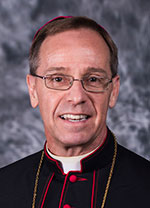Christ the Cornerstone
Christ is revealed in both the giver and the recipient of God’s love

“May St. Martin help us to understand that only by means of a common commitment to sharing is it possible to respond to the great challenge of our time: to build a world of peace and justice where each person can live with dignity.” (Pope Benedict XVI)
Friday, Nov. 11, is the memorial of St. Martin of Tours, one of the most significant figures in the evangelization of Europe. Born in present-day Hungary, Martin grew up in Italy and following his military service, he settled in France.
While still a soldier, he once encountered a poor beggar shivering from the cold in his tattered rags. Instead of passing him by, Martin took off his cloak, tore it in two with his sword, and gave one half to the beggar. That night, the Lord appeared to Martin in a dream wearing the beggar’s half of his cloak.
This powerful story of generosity captured the imaginations of the people of fourth-century Europe and became a symbol of the true meaning of Christian charity. Even later periods of European history and culture found meaning in the story of St. Martin and the beggar—as seen in paintings by El Greco (1578) and van Dyck (1618) that depict this famous scene.
Martin left military service convinced that Christ demanded of him peace, not violence, and he became a monk and hermit, later founding the Abbey of Ligugé, the oldest monastery in Europe. His holiness, pastoral zeal and administrative skill were recognized by the Christian people of the French city of Tours who acclaimed Martin as their bishop.
After reluctantly accepting this call to episcopal ministry, he dedicated himself to evangelization, generous service of his people, and formation of the clergy.
During his Angelus remarks on this feast day in 2007, Pope Emeritus Benedict XVI said that while many miracles are attributed to St. Martin of Tours all across Europe, he is known mainly for the act of charity he performed as a young soldier.
“St. Martin’s charitable gesture flows from the same logic that drove Jesus to multiply the loaves for the hungry crowd,” the Holy Father said, “but most of all to leave himself to humanity as food in the Eucharist, supreme sign of God’s love, sacramentum caritatis.”
Feeding the hungry, clothing the naked, sheltering the homeless are all signs of God’s love. As such, they are actions that symbolize Christ’s giving of himself to us in the holy Eucharist. And these actions are not only symbols, they are concrete expressions of God’s work in the world.
Yes, Christ is visible in the beggar who received half of Martin’s cloak, but he can also be seen in the face of the young soldier who stopped to share what he had with a poor man shivering in the bitter cold. We are all one person in Jesus Christ our Lord. When we give generously, we are Christ. When we receive humbly the gift of God’s love, we are also Christ revealed in the faces of all humankind.
Our archdiocese and dioceses throughout the United States are now preparing for what we pray will be a great renewal of devotion to the holy Eucharist in our time.
The National Eucharistic Revival that is taking place from 2022-25 is a three-year initiative sponsored by the bishops of the United States to inspire and prepare the people of God to be formed, healed, converted, united and sent out to a hurting and hungry world through a renewed encounter with Jesus in the Eucharist—the source and summit of our Catholic faith.
The revival officially began in June, and its milestone event will be a National Eucharistic Congress in Indianapolis from July 17-21, 2024. The National Eucharistic Revival and National Eucharistic Congress are a direct response to Pope Francis’ call for a “pastoral and missionary conversion which cannot leave things as they presently are” so that the Church in the United States might be “permanently in a state of mission” (“Evangelii Gaudium,” #25).
As we engage in this Eucharistic Revival, and prepare for the Eucharistic Congress, there is much we can learn from the witness of St. Martin of Tours who saw the face of Christ in a homeless beggar, and who responded to him by unhesitatingly sharing his cloak with him.
Much work is now being done to prepare for the National Eucharistic Congress which we are privileged to host in less than two years. Please join me in praying: St. Martin of Tours, pray for us. Help us to see Christ in all our brothers and sisters. And teach us to be Christ for those most in need of our help. †
